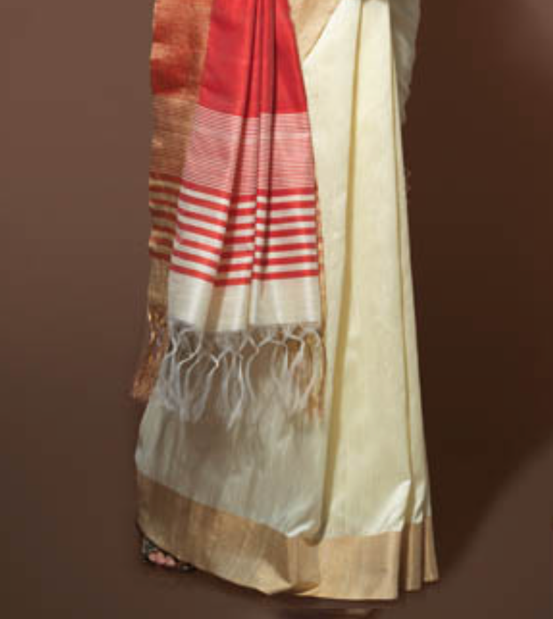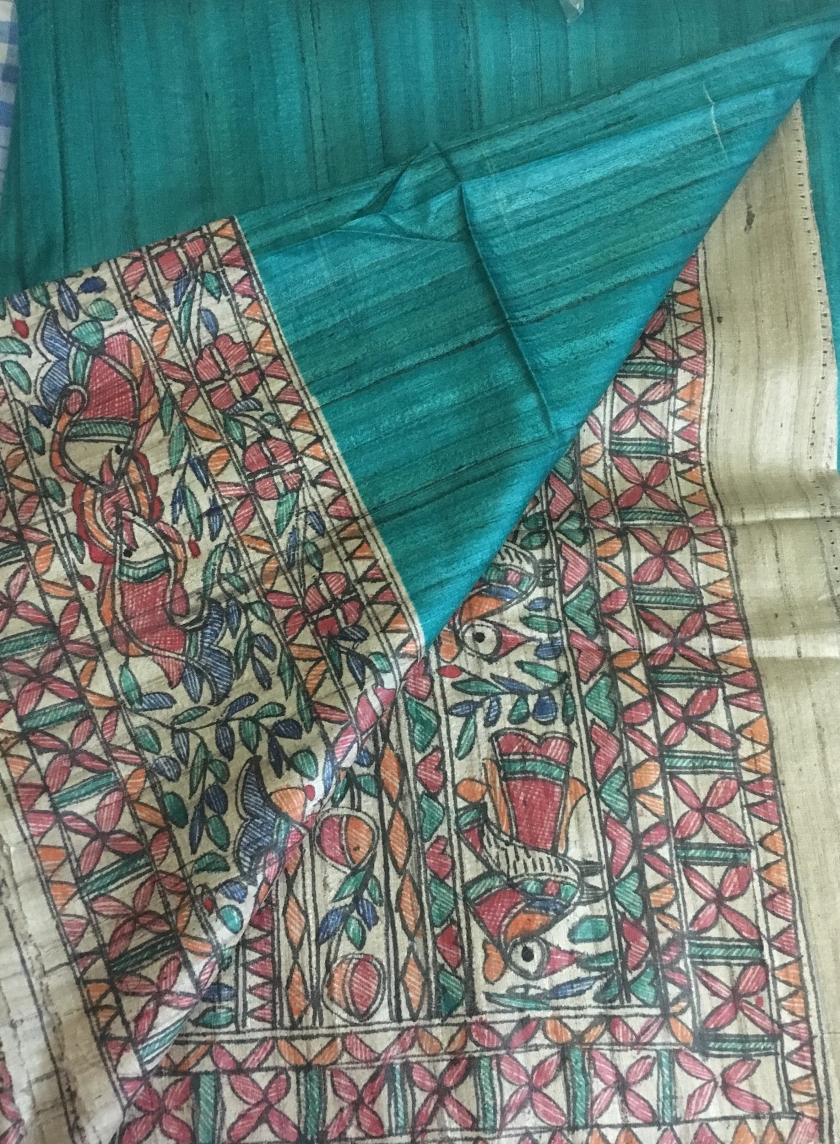It was one typical monsoon afternoon in Mumbai, after scrumptious lunch in Sizzlers near Fort area, parents & I entered through the door of KalaNiketan store on Queens Road. Monsoon in Mumbai can be hot, humid at the same time very cozy and comfortable. As we entered this air-conditioned shop, the sense of comfort and coziness seeped in. Tea was ordered almost immediately as a usual tradition, which means, we are here for a while and plan to buy more than just one saree today. I remember we left the shop 2+ hours later with a few red color logo bags in our hands.
I don’t remember what was the exact occasion of that day’s sari shopping, but all I remember is that is the day I found out my comfort zone in a sari called “Tussar Silk”.
Fast forward few years, I was back in the same shop, with my parents and my daughter, who tagged along with us as she wanted to experience eating a sizzler in Mumbai. I had my mom’s one sari photo on my iPhone, sari being almost as old as me, and I wanted to know what was that sari called. Salesperson was very experienced one, and his instant expert response was it is a “Bhagalpuri Tussar”. I thought isn’t there just one thing called “Tussar”? And through that discussion, I found out what I am about to share here today.
Tussar Silk Saree is an unexampled epitome of delicacy, rich textured attribute, and the natural impression. With a blend of the finest range of threads and best weaving technique, these sarees touch every layer of silk
Origin / History: Tussar Silk , also referred to as ‘Wild Silk, “Forest Silk”, Tassar Silk, or Tusar Silk is an exquisite thread obtained from a wide winged moth that is yellowish-brown in color. They are made from silk that is produced from silk worms that breed on wild forest trees, not mulberry trees.
The scientific name of these moths is Antheraea Paphia and they are a part of the group known as Emperor Moths or Saturnids. These moths are a true wonder of nature. Their wings are embellished by circular markings that look like a mirror. Indeed, when you look closely into those circular markings, you’ll be able to see a reflection of yourself. The worms that produce Tussar silk are not fed mulberry leaves.
This research of silk and moths lead me to read so many other blogs and articles, it was overwhelming at the same time educational. Suddenly I had to start documenting various reference links on fabric, textures, weave etc.
Such as, I learnt that Tussar silk is similar but not same as Raw silk. Raw silk has little uneven weaved finish where as Tussar silk has smooth finish compared to raw silk and has its shine.
Kosa Silk is the Sanskrit name of Tussar. Produced mainly in India, Tussar is highly valued for its natural Gold colors, which it inherits from the Antheria Paphia, Antheria Milita, and Antheria Proylei. As far as the history of the origin of Tussar Silk is concerned, there is very little data regarding the time of its origin. However, borrowing from the history of raw silk, it can be said that Tussar silk was a discovery of the medieval times. Prior to that there wasn’t any trace of Silk being made out of any other natural or artificial object in place of mulberry fed Silk works.
Tussar silk is a lot more textured than any other variety of Silk. The fabric is also cooler than the other varieties and is a lot more porous, therefore, breathable. Being cooler than the other varieties of Silk makes Tussar extremely wearable in warmer parts of the world.

There is no dearth of colors that you can pick in Tussar silk sarees. From the light tones such as beige or golden honey, to the darker and brighter hues like pinks and reds, there is a whole gamut that you can choose from. You can go in for a range of designs ranging from the traditional block styles to the more contemporary ones today·
The overall look and grace that emanates out of such color combinations is something every elegant lady would vouch for.
Even within the Tussar silk fabric, there are a number of classifications. In all, there are 5 types of the fabric that are produced in the silk manufacturing industry. Each of these comes with a hint of cotton mixed with the Tussar warp. When it comes to the most popular ones, it is the pure Tussar fabric, or the Tussar cotton that sells the most.
Wrap is kora silk and weft is mercerized cotton in Tussar cotton sarees.
Warp and Weft detailed definitions later when we talk about Linen saree type in some other week, it will be much easier to explain in the context.
Indian households are known to have a tradition of dressing up in ethnic wear; be it special occasions or the casual family gatherings, tradition is deeply rooted in our culture. And Tussar silk is the perfect symbol of this tradition.
Region: Bihar & Chattisgarh
Its common name is “Tussar”, “Kosa” as famous in Champa District of Chhattisgarh and “Bhagalpuri Tussar Silk” or “Bhagalpuri Silk” in Bihar. In India, the manufacture of Tussar is largely catered to by the tribal people.
Tribal women who are trained in the art of Tussar silk weaving can produce about 10 meters of the silk cloth in around three days. Amazing, isn’t it ?
A lot of India’s Tussar silk saree production happens in Bhagalpur in Bihar. In fact, the silk weaving industry in this region goes back over a century! Hence, Bhagalpuri silk sarees are just as popular name, as majority of Bhagalpuri sarees are actually Tussar silk sarees.
Apart from Bhagalpur, Champa, Tussar silk is also produced in Orissa, West Bengal, Madhya Pradesh and Jharkhand in recent years.
Though cheaper than mulberry silk, a genuine Tussar silk saree will still cost you anywhere between Rs.3,000 to Rs.7,000. Tussar silk sarees are delicate and need to be dry cleaned only. Store them in muslin bags to allow the fabric to breathe.
Tussar silk sarees come in a variety of color combinations; the usual norm is to pair a neutral tone such as a beige or a honey with something bright such as pink, green, red, and the like. Sample photos shared separately below.
Where to buy from:
Some well-known places in Mumbai where I find variety of Tussar sarees are,
- FabIndia
- KalaNiketan
- Handloom House
Few online options that I have recently bought from are,
– Directly from weavers
– https://GoCoop.com

Personally, I own two such sarees, one Bhagalpuri Tussar Silk and one Kosa Tussar Silk. Bhagalpuri Tussar bought from Kalaniketan Sarees in Mumbai and Kosa Silk from a boutique in Churni Road, Mumbai.
I love these sarees as “can-wear-for-any-occasion” and my natural comfort zone sarees. I also have many more every day wear tunics in Tussar as well.
How about you ?


Reference Details:
All Pictures credited from Internet.
https://www.utsavpedia.com/textiles/tussar-silk-the-story-of-wild-silk/
https://en.m.wikipedia.org/wiki/Tussar_silk
http://blog.brijraj.com/6-things-you-must-know-about-tussar-silk-sarees/
http://www.craftsvilla.com/blog/tussar-silk-sarees-history-facts-fabric/
http://www.craftsvilla.com/blog/8-things-you-didnt-know-about-tussar-silk-sarees/
http://www.craftmark.org/sites/default/files/Tussar%20Weaving%20.pdf
